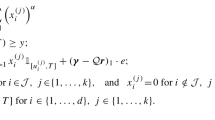Abstract
Consider the problem of predicting loss ratios for traffic streams sharing a buffer. Approximations based on the temporal statistical properties of single sources do not account for the economies of scale which can arise when there is statistical multiplexing gain across sources. These can occur whether the sources have long or short range dependence; in either case the economies may be positive or negative. In this paper we investigate this matter for sources described by fractional ARIMA processes, and show that their short‐range structure can mean that a simple power‐law tail based on the Hurst parameter alone can be over‐optimistic when the buffer space allocated per source is not large.
Similar content being viewed by others
References
N.H. Bingham, C.M. Goldie and J.L. Teugels, Regular Variation, Encyclopedia of Mathematics and its Applications, Vol. 27 (Cambridge University Press, Cambridge, 1987).
D.D. Botvich and N.G. Duffield, Large deviations, the shape of the loss curve, and economies of scale in large multiplexers, Queueing Systems 20 (1995) 293–320.
D.D. Botvich, T.J. Corcoran, N.G. Duffield and P. Farrell, Economies of scale in long and short buffers of large multiplexers, in: Proceedings of 12th IEE UK Teletraffic Symposium, Old Windsor (15-17 March 1995).
C.S. Chang, Stability, queue length and delay of deterministic and stochastic queueing networks, IEEE Trans. Automat. Control. 39 (1994) 913–931.
G.L. Choudhury, D.M. Lucantoni and W. Whitt, Squeezing the most out of ATM, IEEE Trans. Comm. 44 (1996) 203–217.
C. Courcoubetis and R. Weber, Buffer overflow asymptotics for a switch handling many traffic sources, J. Appl. Prob. 33 (1996) 886–903.
C. Courcoubetis, G. Fouskas and R. Weber, An on-line estimation procedure for cell loss probabilities in ATM links, in: Proceedings of the Third IFIP Workshop on Performance Modelling and Evaluation of ATM Networks, Ilkley (2-6 July 1995).
C. Courcoubetis, G. Kesidis, A. Ridder, J. Walrand and R.R. Weber, Admission control and routing in ATM networks using inferences from measured buffer occupancy, IEEE Trans. Comm. 43 (1995) 1778–1784.
A. Dembo and O. Zeitouni, Large Deviation Techniques and Applications (Jones and Bartlett, Boston, 1993).
N.G. Duffield, Economies of scale in queues with sources having power-law large deviation scalings, J. Appl. Prob. 33 (1996) 840–857.
N.G. Duffield, Conditioned asymptotics for tail probabilities in large multiplexers, Performance Evaluation, to be published.
N.G. Duffield and N. O'Connell, Large deviations and overflow probabilities for the general single-server queue, with applications, Math. Proc. Cambridge Philos. Soc. 118 (1995) 363–374.
N.G. Duffield, J.T. Lewis, N. O'Connell, R. Russell and F. Toomey, Entropy of ATM traffic streams: a tool for estimating QoS parameters, IEEE JSAC 13 (1995) 981–990.
N.G. Duffield, J.T. Lewis, N. O'Connell, R. Russell and F. Toomey, Predicting quality of service for traffic with long-range fluctuations, in: Proceedings of IEEE International Conference on Communications, Seattle (18-22 June 1995) pp. 473–477.
P.W. Glynn and W. Whitt, Logarithmic asymptotics for steady-state tail probabilities in a single-server queue, J. Appl. Prob. 31A (1993) 131–159.
I.S. Gradstheyn and I.W. Ryzhik, Table of Integrals, Series and Products (Academic Press, New York, 1965).
D.P. Heyman and T.V. Lakshman, What are the implications of long-range dependence on VBR-video traffic engineering, IEEE Transactions on Networking 4 (1996) 301–317.
J.R.M. Hosking, Fractional differencing, Biometrika 68 (1981) 165–176.
F.P. Kelly, Effective bandwidths at multi-type queues, Queueing Systems 9 (1991) 5–16.
W.E. Leland, M.S. Taqqu, W. Willinger and D.V. Wilson, On the self-similar nature of Ethernet traffic, ACM SIGCOMM Computer Communications Review 23 (1993) 183–193.
B.B. Mandelbrot and J.W. Van Ness, Fractional Brownian motions, fractional noises and applications, SIAM Review 10 (1968) 422–437.
I. Norros, A storage model with self-similar input, Queueing Systems 16 (1994) 387–396.
B.K. Ryu and A. Elwalid, The importance of long-range dependence of VBR video traffic in ATM traffic engineering, in: Proceedings ACM SIGCOMM (1996).
A. Simonian and J. Guibert, Large deviations approximation for fluid queues fed by a large number of on-off sources, in: Proceedings 14th ITC (1994) pp. 1013–1022.
A. Weiss, A new technique for analyzing large traffic systems, J. Appl. Prob. 18 (1986) 506–532.
W. Whitt, Tail probabilities with statistical multiplexing and effective bandwidths in multi-class queues, Telecommunication Systems 2 (1993) 71–107.
Author information
Authors and Affiliations
Rights and permissions
About this article
Cite this article
Duffield, N. Economies of scale for long‐range dependent traffic in short buffers. Telecommunication Systems 7, 267–280 (1997). https://doi.org/10.1023/A:1019128530075
Issue Date:
DOI: https://doi.org/10.1023/A:1019128530075




